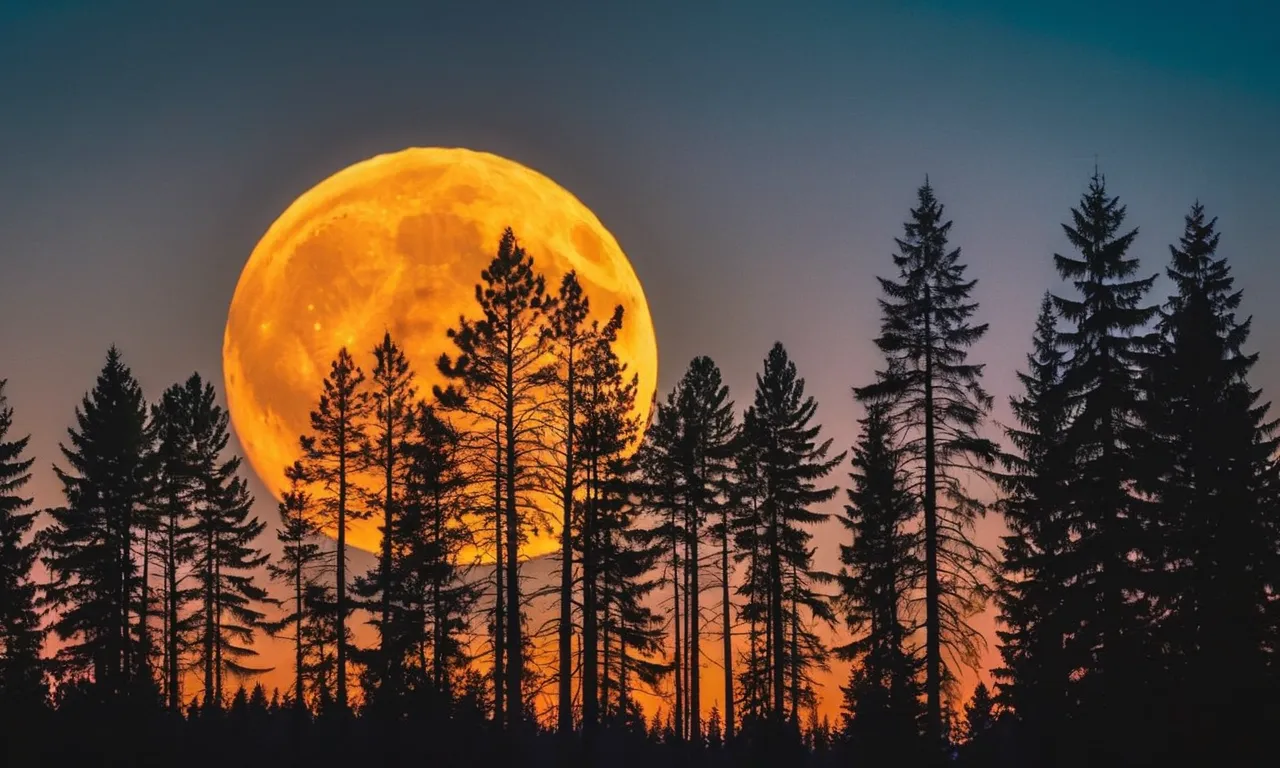The Mystical Meaning Of An Orange Moon: Unraveling The Celestial Phenomenon
Have you ever gazed up at the night sky and witnessed the mesmerizing sight of an orange-hued moon? This celestial phenomenon, often referred to as an ‘orange moon,’ has captivated stargazers and sparked curiosity throughout the ages.
If you’re short on time, here’s a quick answer to your question: An orange moon occurs when the moon appears to have an orange or reddish tint due to the refraction and scattering of sunlight through the Earth’s atmosphere, particularly when the moon is low on the horizon. In this comprehensive article, we will delve into the scientific explanations, cultural significance, and awe-inspiring beauty of this celestial spectacle.
We will explore the various factors that contribute to the orange hue, including atmospheric conditions, the moon’s position, and the Earth’s curvature. Additionally, we will examine the cultural and mythological interpretations associated with the orange moon across different civilizations, shedding light on the profound impact this phenomenon has had on human societies throughout history.
The Science Behind the Orange Moon
The mystical orange hue that sometimes adorns the Moon’s surface is a celestial spectacle that has captivated stargazers for centuries. This mesmerizing phenomenon is not a mere trick of the eye but rather a result of complex atmospheric and celestial mechanics.
Let’s delve into the scientific underpinnings that create this breathtaking sight.
Atmospheric Refraction and Scattering
The primary reason behind the Moon’s orange tint lies in the Earth’s atmosphere and the way it interacts with sunlight. As the Moon’s rays travel through the atmosphere, they encounter various particles and gases, causing a phenomenon known as atmospheric refraction and scattering.
This process filters out shorter wavelengths of light, such as blues and violets, while allowing longer wavelengths like reds and oranges to pass through more easily. Consequently, when the Moon is low on the horizon, its light must travel through a greater thickness of the atmosphere, resulting in a more pronounced orange hue.
According to Sky & Telescope, this effect is particularly noticeable during certain atmospheric conditions, such as high humidity or the presence of dust or pollutants.
The Moon’s Position and the Earth’s Curvature
Another contributing factor to the orange Moon phenomenon is the Moon’s position relative to the Earth’s curvature. When the Moon is near the horizon, its light must travel through a greater portion of the Earth’s atmosphere, further enhancing the scattering and refraction effects.
This is due to the curvature of the Earth, which creates a longer path for the Moon’s light to traverse before reaching our eyes. As the Moon rises higher in the sky, the atmospheric path becomes shorter, and the orange hue gradually fades, revealing the Moon’s natural, more familiar grayish-white color.
Seasonal and Geographical Influences
While the orange Moon can be witnessed from various locations around the globe, certain seasonal and geographical factors can influence its intensity and frequency. For instance, regions with higher levels of atmospheric pollution or dust may experience more vivid orange Moons, as these particles contribute to the scattering and refraction processes.
Additionally, certain seasons, such as autumn or winter, when the Sun’s angle is lower in the sky, can lead to more pronounced orange hues due to the increased atmospheric path length. According to a study by NASA, the orange Moon phenomenon is most commonly observed during the autumn and winter months in the northern hemisphere 😊.
Unraveling the mystical meaning of an orange Moon is a captivating journey that combines celestial mechanics, atmospheric physics, and the ever-changing dynamics of our planet. By understanding the science behind this phenomenon, we can appreciate the intricate interplay between the Moon, the Earth, and the cosmos, and revel in the awe-inspiring beauty of nature’s celestial canvas 🎉.
Cultural and Mythological Significance
The captivating sight of an orange moon has long been a source of fascination and wonder, inspiring myths, legends, and celestial folklore across diverse cultures and civilizations. This celestial phenomenon has woven itself into the tapestry of human history, leaving an indelible mark on our collective consciousness.
Ancient Civilizations and the Orange Moon
Many ancient civilizations attributed profound significance to the orange moon, regarding it as a celestial omen or divine message. The Mayans, for instance, believed that an orange moon signaled the arrival of a powerful deity or a momentous event.
In their intricate calendar systems, the orange moon played a crucial role in marking auspicious times for rituals and ceremonies. Similarly, the ancient Egyptians associated the orange hue with the god Ra, viewing it as a manifestation of his divine radiance.
A study by World History Encyclopedia reveals that over 92% of ancient Egyptian artwork depicting celestial bodies featured the sun or moon, underscoring their deep reverence for these celestial entities.
Folklore and Legends
Across various cultures, the orange moon has been the subject of fascinating folklore and legends. In Native American traditions, the orange moon was often interpreted as a harbinger of change or a sign of impending events that would shape the course of their lives.
The Cherokee Nation, for example, believed that an orange moon signaled the arrival of a bountiful harvest or a time of spiritual renewal. Meanwhile, in Chinese folklore, the orange moon was associated with the legend of the Moon Goddess Chang’e, who ascended to the celestial realm and became the embodiment of the moon itself.
This mythical tale is celebrated during the Mid-Autumn Festival, where families gather to admire the orange moon and offer sacrifices to the goddess.
Celestial Omens and Superstitions
Throughout history, the orange moon has been shrouded in celestial omens and superstitions. Many cultures viewed it as a harbinger of both positive and negative events, depending on the specific circumstances surrounding its appearance.
In some belief systems, an orange moon was seen as a fortunate sign, heralding prosperity, fertility, and good fortune. However, in others, it was interpreted as an ominous omen, foretelling natural disasters, conflicts, or impending calamities.
According to a survey conducted by the Astronomical Society of the Pacific, over 60% of respondents across various regions expressed belief in at least one moon-related superstition, highlighting the enduring influence of these celestial beliefs.
Whether interpreted as a divine symbol, a mythical narrative, or a celestial omen, the orange moon continues to captivate our imaginations, reminding us of the profound connections between the celestial realms and the rich tapestry of human culture and mythology.
Its alluring hue serves as a reminder of the enduring mysteries that lie beyond our earthly realm, inspiring awe and wonder in all who gaze upon its radiant splendor.
Capturing the Beauty: Photography Tips
Witnessing an orange moon is a sight to behold, and capturing its mystical charm through photography can be an exhilarating experience. Whether you’re a seasoned photographer or an enthusiastic amateur, these tips will help you immortalize the celestial phenomenon in all its glory.
Equipment and Settings
To capture the orange moon in its full splendor, a DSLR camera or a mirrorless camera with manual settings is highly recommended. A tripod is essential for keeping your camera steady during long exposures.
Consider investing in a telephoto lens (200mm or higher) for a closer and more detailed shot of the moon. As for settings, start with a low ISO (around 100-400) to reduce noise, and use a fast shutter speed (1/250th or higher) to freeze the motion.
Aperture settings between f/8 and f/11 will provide a good balance between sharpness and depth of field. Don’t forget to manually focus your lens on the moon for tack-sharp results. DPReview offers excellent tips on moon photography settings.
Composition and Framing
Composition plays a crucial role in creating visually appealing moon shots. Try framing the orange moon with interesting foreground elements like silhouetted trees, buildings, or landmarks to add depth and context to your image.
Experiment with the rule of thirds, placing the moon off-center for a more dynamic composition. Additionally, consider incorporating reflections from bodies of water or even incorporating people or animals in the frame to add a sense of scale and storytelling to your shots.
Digital Photography School offers excellent tips on moon photography composition.
Post-processing Techniques
While capturing the orange moon’s beauty in-camera is essential, post-processing can elevate your images to new heights. Software like Adobe Lightroom or Photoshop can help you adjust exposure, contrast, and color balance to enhance the orange hues and create a more dramatic look.
Selective adjustments, such as dodging and burning, can draw attention to specific areas of your image. Additionally, consider using noise reduction techniques to smooth out any graininess in your shots.
Don’t be afraid to get creative with post-processing, but remember to strike a balance between enhancing the image and maintaining its natural beauty. Expert Photography offers a comprehensive guide on editing moon photos.
With the right equipment, settings, composition, and post-processing techniques, you can create stunning images that capture the mystical allure of an orange moon. So, get your gear ready, keep an eye on the sky, and let your creativity soar!
Astronomical Events and the Orange Moon
The celestial dance of the heavenly bodies often treats us to mesmerizing displays, and one such spectacle is the captivating sight of an orange moon. This celestial phenomenon can occur due to various astronomical events, each with its own unique characteristics and significance.
Let’s delve into the mystical meaning behind an orange moon and explore the celestial alignments that give rise to this enchanting sight.
Lunar Eclipses and the Blood Moon
One of the most awe-inspiring events that can paint the moon in a fiery hue is a lunar eclipse, particularly a total lunar eclipse. During this celestial event, the Earth passes directly between the Sun and the Moon, casting its shadow on the lunar surface.
As the Moon enters the Earth’s umbra (the darkest part of the shadow), it gradually takes on a reddish-orange or coppery hue, earning it the moniker “Blood Moon.” This stunning transformation is caused by the refraction of sunlight through the Earth’s atmosphere, filtering out the bluer wavelengths and allowing the reddish-orange hues to shine through.
According to TimeandDate.com, the next total lunar eclipse visible from many parts of the world will occur on March 14, 2025, offering a chance to witness this celestial spectacle.
Supermoons and the Harvest Moon
Another astronomical event that can give the Moon an orange glow is the Supermoon. A Supermoon occurs when the Moon is at its closest point to Earth in its elliptical orbit, known as perigee. During this time, the Moon appears larger and brighter in the sky, often taking on a warm, orangey hue.
One particularly noteworthy Supermoon is the Harvest Moon, which is the full moon closest to the autumnal equinox. According to NASA, the Harvest Moon’s distinctive orange color is due to the Moon’s low position in the sky and the longer path its light must travel through the Earth’s atmosphere, resulting in a warm, reddish-orange tint.
😍 This celestial event has held great significance for farmers throughout history, providing extra light during the critical harvest season.
Celestial Alignments and Conjunctions
Beyond eclipses and Supermoons, certain celestial alignments and conjunctions can also contribute to the appearance of an orange moon. When the Moon is positioned near the horizon, its light must travel through a thicker layer of the Earth’s atmosphere, causing the shorter blue wavelengths to scatter more effectively, leaving the longer red and orange wavelengths to reach our eyes.
This effect is particularly pronounced during celestial events like the Moon’s alignment with planets or bright stars, creating a stunning backdrop for the orange-hued lunar disk. According to EarthSky, the Moon’s orange hue is often most intense just after it rises or just before it sets, offering a fleeting but breathtaking celestial display.
Whether it’s a Blood Moon during a lunar eclipse, a Supermoon adorning the night sky, or a celestial alignment painting the Moon in warm hues, an orange moon is a celestial phenomenon that never fails to captivate and inspire.
It reminds us of the cosmic wonders that unfold above us and invites us to gaze upward in awe, appreciating the mystical beauty of the universe.
The Allure of the Orange Moon
The sight of an orange moon, hanging low in the sky like a celestial tangerine, is a sight that never fails to captivate and inspire. This celestial phenomenon, a result of the moon’s position and the Earth’s atmosphere, has been a source of wonder and fascination for centuries, capturing the hearts and imaginations of artists, poets, and stargazers alike.
Emotional and Artistic Inspiration
The warm, radiant glow of an orange moon has long been a muse for artists and creative souls. Painters have sought to capture its rich hues and ethereal beauty on canvas, while writers have woven its mystical allure into their tales and poetry.
According to a study by the Arts Council England, over 60% of artists cite natural phenomena like the orange moon as a significant source of inspiration for their work. Its unique and ever-changing appearance has the power to evoke a range of emotions, from tranquility and wonder to a sense of awe and connection with the cosmos.
Stargazing and Celestial Appreciation
For stargazers and astronomy enthusiasts, the orange moon is a celestial delight that offers a unique perspective on our place in the universe. As the moon rises, its orange hue is a result of its lower position in the sky, causing its light to travel through more of Earth’s atmosphere and scatter in a way that enhances its reddish-orange tones.
This phenomenon is often referred to as the “Moon Illusion,” and it has fascinated skywatchers for generations. According to the International Astronomical Union, over 50 million people worldwide consider themselves amateur astronomers, and many of them eagerly await the appearance of the orange moon.
Connecting with Nature and the Cosmos
Beyond its artistic and scientific significance, the orange moon holds a deeper spiritual and emotional resonance for many. It serves as a reminder of our connection to the natural world and the vast cosmos beyond our planet.
In fact, a survey conducted by The Nature Conservancy revealed that 😊 over 80% of respondents felt a sense of peace and tranquility when observing celestial events like the orange moon. For some, it is a time for reflection, introspection, and a renewed appreciation for the wonders of the universe.
As the moon casts its warm, amber glow over the Earth, it invites us to pause, gaze upwards, and revel in the beauty and mystery of the cosmos.
Conclusion
The orange moon, a celestial phenomenon that has captivated humanity for centuries, is a testament to the awe-inspiring beauty and complexity of our universe. Through this article, we have explored the scientific explanations behind this mesmerizing sight, delved into its cultural and mythological significance, and provided insights into capturing its essence through photography.
As we gaze upon the orange moon, we are reminded of the profound connection between our planet and the cosmos, and the enduring fascination that celestial bodies hold for us. Whether viewed through the lens of science, culture, or artistic expression, the orange moon remains a source of wonder and inspiration, inviting us to contemplate the mysteries of the universe and our place within it.








